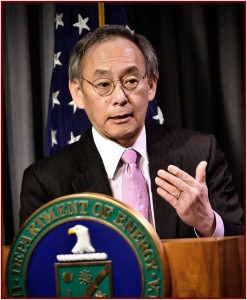
The U.S. spent $430 billion dollars on foreign oil in 2012, a direct wealth transfer out of the country. Billions more are spent to keep oil shipping lanes open and oil geo-politics to a costly Defense budget.
After four years serving in the Cabinet of the Obama Administration, Energy Secretary Steven Chu is resigning from a complicated, often thankless job running an agency with a $25 billion annual budget. Dr. Chu will return to academic research in California after a new Energy Secretary is appointed.
The Department of Energy, oft mocked by right wing Republicans, in Chu’s mind actually serves U.S. taxpayers as a Department of Science, a Department of Innovation, and a Department of Nuclear Security.
Through the Recovery Act, the Department of Energy made grants and loans to more than 1,300 companies. Nevertheless, Republican critics and other ideologues continue to criticize the program. Only 1% of the companies DOE funded went bankrupt. The failures are the price of progress.
DOE accomplishments, sometimes building on earlier government research programs, are notable, significant and proof that government can make a positive difference in areas where the free market fails and/or private enterprise ignores or, worse in lobbyist-ridden Washington, deliberately thwarts to maintain the status quo.
During the last four years, the production of renewable energy from wind and solar has doubled. Part of this came by the Obama Administration’s investments in the development and deployment of the latest technologies, which in the case of what became a bankrupt Solyndra was not without political controversy. Often overlooked here is the fact that the U.S. now has first national rooftop solar project that will include commercial buildings in up to 28 states. Indeed, installations of solar photovoltaic systems have almost doubled in each one of the last three years, and are now exceeding 1.8 gigawatts. According to AWEA, last year 42% of new energy capacity in the U.S. was from wind – more than any other energy source.
The United States spent $430 billion dollars on foreign oil in 2012, a direct wealth transfer out of the country. Billions upon billions more are spent to keep oil shipping lanes open and oil geo-politics to a costly Defense budget. U.S. oil imports will fall to a 25 year low next year, but we stall are paying an unacceptable economic, national security and human cost for this addiction.
DOE was given $36 billion through the Recovery Act and after fumbling a bit in the beginning – special interests again as well as a rush to get money out – it started a review process that looked at the proposals with what now appears to be sufficient anti-pork skepticism, albeit with a tolerance for the risk entailed by alternative energy or advanced technology startups.
DOE administered a loan program authorized by Congress under the Bush administration. The program generated a portfolio of loans and loan guarantees to 33 clean energy and advanced automotive manufacturing projects that it is claimed will support 60,000 jobs and generate $55 billion in economic investment.
More than a dozen auto plants were built, reopened, or helping auto industry compete and produce the next generation of American-made vehicles that will be the cleanest, most fuel-efficient, highest quality vehicles ever produced if current trends continue. DOE has collaborated with industry to eliminate expensive and time-consuming engineering prototyping in applications as varied as simulations that have been used to optimize diesel and jet engines, tire treads and the safety of nuclear reactor fuel assemblies.
DOE has also worked with industry to eliminate expensive, time consuming engineering prototyping in applications as varied as simulations that have been used to optimize diesel and jet engines, tire treads and the safety of nuclear reactor fuel assemblies.
On a more prosaic level, DOE has helped one million low-income homeowners weatherize their homes. Obama’s Better Buildings Challenge secured $2 billion in commitments from more than 100 major companies, universities, hospitals, retailers, cities and states to upgrade 2 billion square feet of commercial and industrial space by 2020.
During the last two years, the private sector, including Warren Buffett, Bank of America, Wells Fargo and Google, have announced major investments in clean energy a sign that lenders and investors now think renewable energy will profitable.

